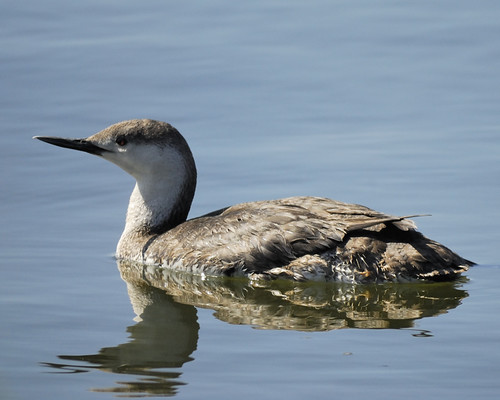tags: Red-throated Loon, Red-throated Diver, Gavia stellata, birds, mystery bird, bird ID quiz
[Mystery bird] Red-throated Loon, also known as the Red-throated Diver, Gavia stellata, photographed at Bodega Bay, California. [I will identify this bird for you in 48 hours]
Image: Joseph Kennedy, 12 May 2010 [larger view].
Nikon D200, Kowa 883 telescope with TSN-PZ camera eyepiece 1/1000s f/8.0 at 1000.0mm iso400.
Please name at least one field mark that supports your identification.
This bird has a character that sets it apart from the others in the same genus and family, and this character has large effects upon the bird's behavior. Can you tell me what this one character is?
This species is the smallest and lightest loon in its taxonomic family, with the largest wing-beat amplitude, all features that make it the only member of its family that can take off from the ground, or alight directly on it.


This bird is unique in its genus, family, and, yes, even its order in a number of ways, so I'm not sure which of these ways intrigues you, GrrlScientist. It has VSTOL capabilities which all its relatives lack, and in fact can even take off from dry land, even if it isn't on the dry land much. None of its relatives can do this.
This bird's molt is different from all its relatives'. While all the members of this genus drop all their flight feathers simultaneously, thus rendering themselves flightless for up to a month, only this one does that during the fall; all the others molt their flight feathers in late winter.
A character that has an effect on behavior? I don't see any differences in behavior except for those in the Sea of Japan that (used) to be tamed to herd fish into nets...maybe that's just a "fish" story ---
oooh, you're good, pete. have i mentioned that lately?
it's probably not a very clearly worded question, or perhaps it's misleading in its wording? think of a physical character that would have an effect on behavior ..
I'd never heard that, Murray -- I know of cormorants that are trained to bring fish back to a boat, but I've never heard of loons being tamed.
I was so confused by Murray's comment, because that didn't look like a cormorant beak, but I didn't know that it really looked like a loon, either. But if Psweet's confused, then it's okay that I am, too :)
Common?
Bardiac -- a Common would have a heavier bill, with similar shapes for the upper and lower mandibles, which means none of the upturned effect of this bird. A Common would also have a 'jagged' appearance to the edge between the gray and the white on the throat, with gray extending farther forwards, and with paler wedges extending into the gray.
Why, thank you GrrlScientist! I can see that psweet and I are on the same page here, but I'm still trying to figure out one of this bird's characters that affects its behavior so strongly. It's the smallest of its admittedly small tribe, the most northerly breeder, and the most widespread. Its short take-off and landing capability allows it to nest at smaller ponds than any of its relatives; if the smaller bodies of water lack suitable forage, they'll fly to other, larger ones to feed. Mated pairs have a duetting 'long call', which is apparently unshared by congeners. Hmmm...